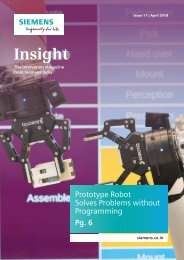Insight_PDF For Web
Create successful ePaper yourself
Turn your PDF publications into a flip-book with our unique Google optimized e-Paper software.
One-hundred percent uptime<br />
Safety and security are one<br />
aspect of operating a data<br />
center. The other is uptime.<br />
“Our internal goal is 100<br />
percent uptime. In the five<br />
years the EAGLE DataCenter in<br />
Munich has been open, we’ve<br />
achieved that,” says Kohler.<br />
Here, redundancy is the<br />
watchword, and it applies to<br />
systems ranging from<br />
air-conditioning components to<br />
those managing the facility’s<br />
power supply. <strong>For</strong> example, if the facility’s<br />
electricity were to be cut off, a diesel<br />
engine would spring to life to supply the<br />
necessary power. The data center can<br />
operate for 48 hours on a tank of fuel.<br />
Always up means electricity is constantly<br />
flowing into the data center. In fact,<br />
worldwide, data centers are responsible<br />
for 1.5 to 2 percent of all energy demand.<br />
But the Munich site is an exception, as its<br />
power comes from renewable sources and<br />
built-in efficiency. <strong>For</strong> instance, waste<br />
heat from the servers contributes to<br />
heating the building in the winter.<br />
The building itself was built to use as little<br />
energy as possible; for instance, it is<br />
equipped with a raised floor in the server<br />
rooms, which facilitates low-energy<br />
air-conditioning equipment. The servers<br />
are also configured so that energy<br />
consumption is as low as possible. These<br />
efforts have helped contribute to the data<br />
center’s internationally recognized LEED<br />
Gold certification, which is issued by the<br />
U.S Green Building Council.<br />
Guardians of highly classified data: Christian Böhm (left) and Uli Kohler from the EAGLE DataCenter<br />
Model of excellence<br />
“The EAGLE facility is Siemens<br />
Building Technologies’ top<br />
reference site for its data center<br />
expertise,” comments Kohler.<br />
Wherever possible, Siemens<br />
technologies were installed.<br />
The result is a living example of<br />
what Siemens is capable of –<br />
from state-of-the-art security to<br />
high uptime and energy<br />
efficiency.<br />
To safeguard its flagship status,<br />
the facility is continuously<br />
evolving. “We do everything<br />
possible to keep our power consumption<br />
as low as possible. We therefore trace our<br />
power usage effectiveness (PUE) to ensure<br />
that our supporting systems are efficient.<br />
That means that when it is commercially<br />
reasonable to do so, we replace hardware<br />
with more energy efficient systems,” says<br />
Kohler. The team also employs high<br />
virtualization rates to make the most of<br />
existing servers.<br />
Everyday, new data is added to Siemens’<br />
treasure trove – data that is essential to<br />
the company’s operations as well as those<br />
of its customers. Today, all of Siemens’<br />
EAGLE DataCenters collectively hold 8<br />
Petabytes of data – that’s 8,000 Terabytes.<br />
The majority of the data is in the Munich<br />
facility, which now holds around 6<br />
Petabytes. When it can hold no more,<br />
there’s room to construct a twin facility at<br />
the site. That will provide more space for<br />
one of the prized possessions of the 21st<br />
century: data.<br />
• Alexander Chavez<br />
Taken from Pictures of the Future, the Siemens<br />
Magazine for Research and Innovation<br />
<strong>For</strong> more information,<br />
write to insight.in@siemens.com<br />
9



